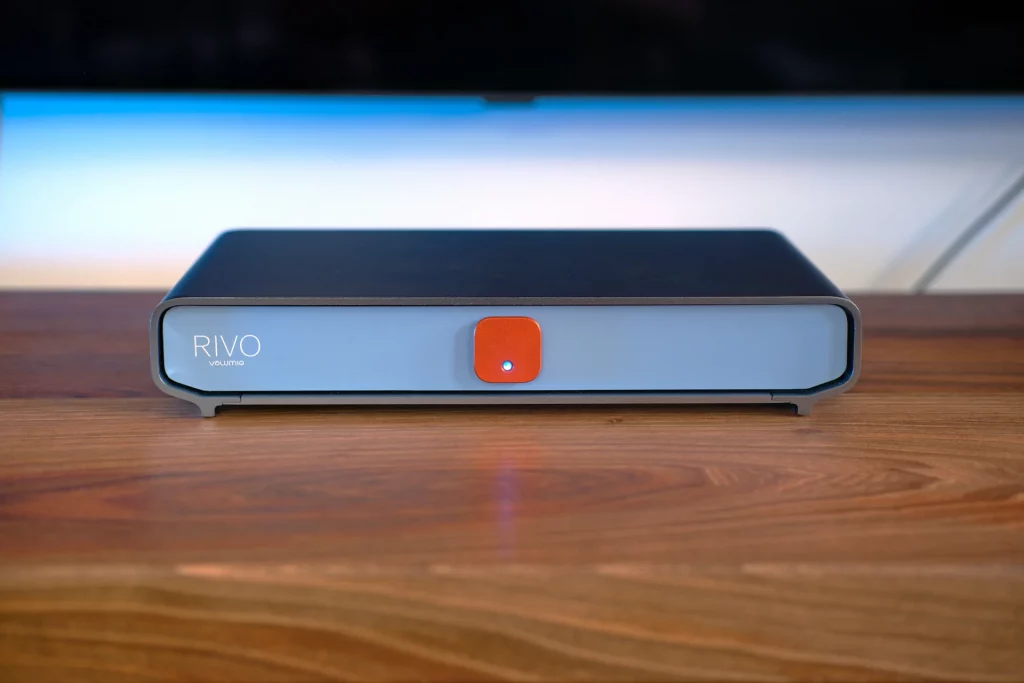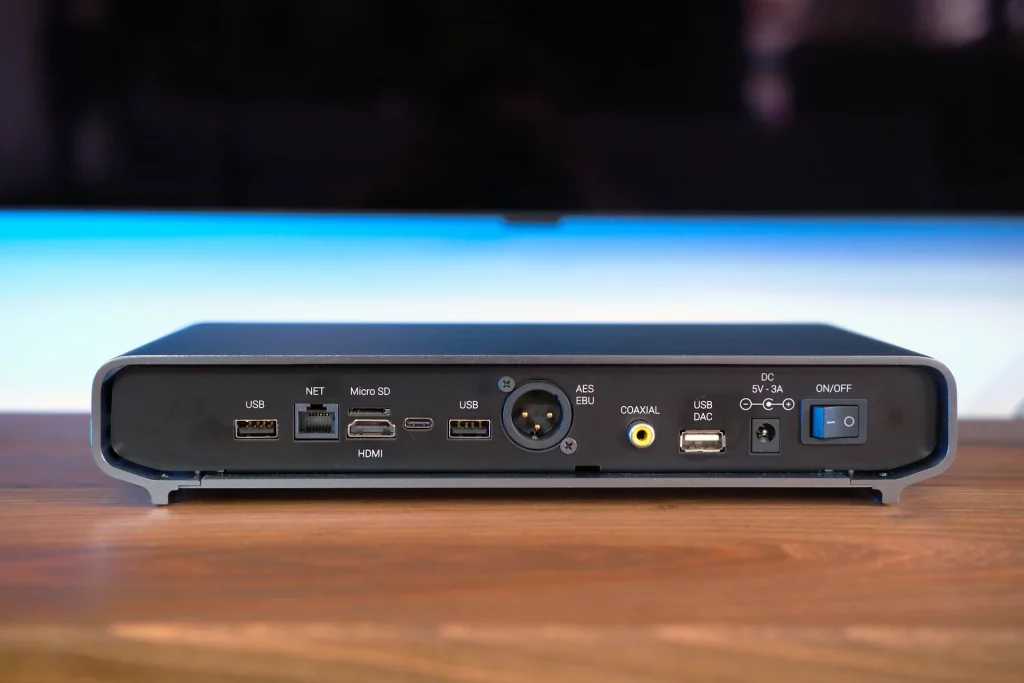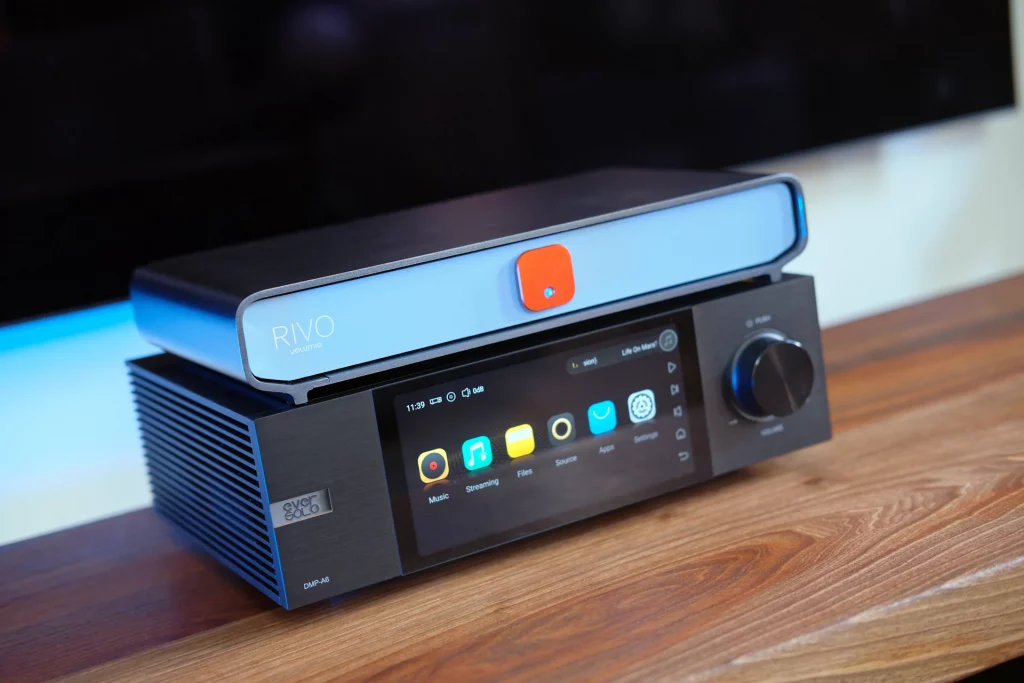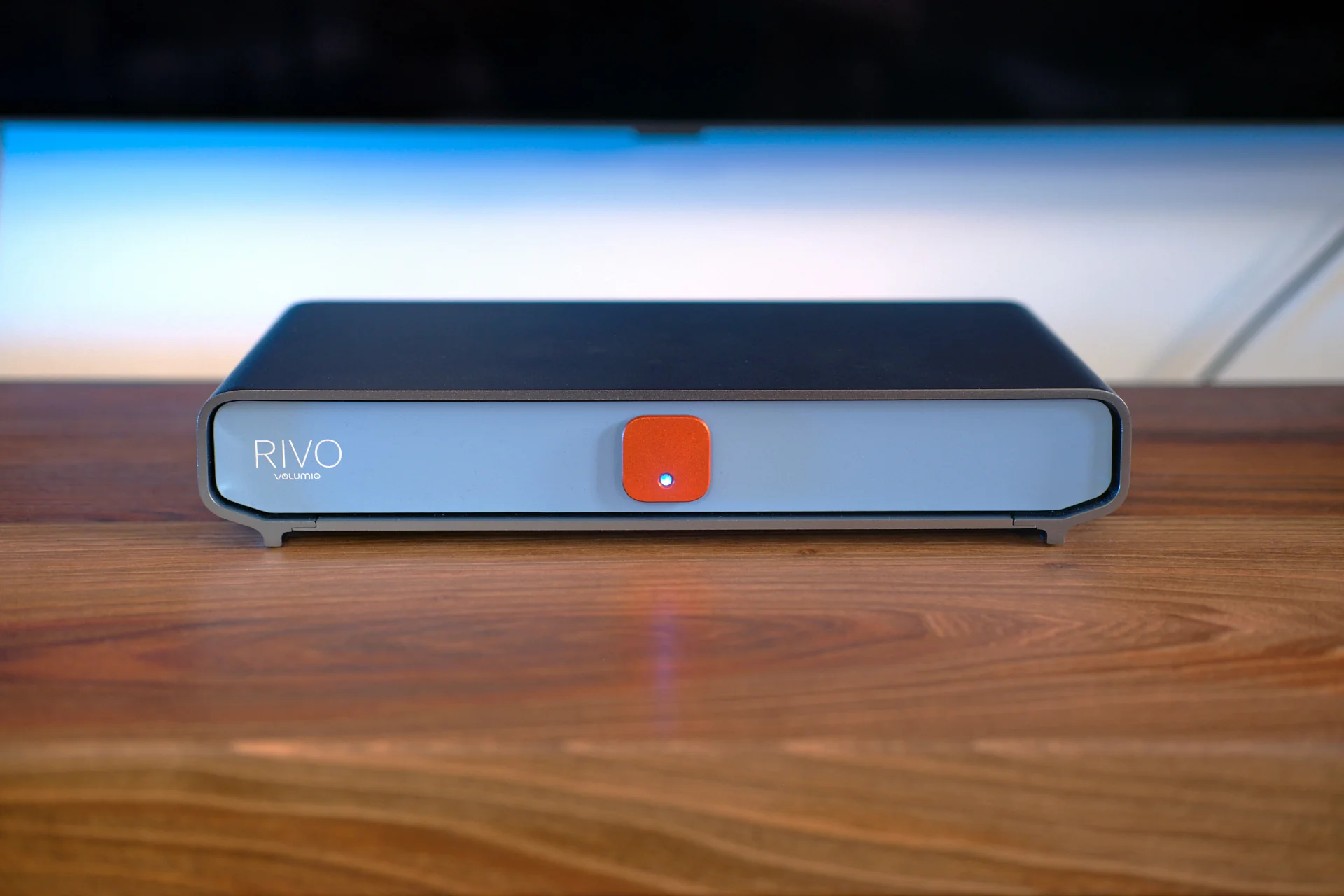Volumio Rivo comes from the same company that makes the well-known Volumio OS, which is more than known among Raspberry Pi streaming enthusiasts. But recently, Volumio started dabbling into hardware to offer complete user-friendly streaming solutions. So let’s see how that went.
Build and Features
Volumio Rivo is mostly made out of aluminium that stylishly bends from the top of the unit to its sides and bottom. Front and back panels appear to float and are made out of some sort of plastic. Looking at the front of the unit, the only thing we see is one big red button that powers the unit on and off. Everything else is done through the app itself. Back is much more interesting with a wide choice of digital connections – USB-A (for DAC), USB-A (for storage), USB-C, LAN, HDMI, Coaxial, and AES/EBU. There’s a slot for a Micro SD card too.


As you can notice in the picture above, the power supply needed for this unit is 5VDC (3A). A small wall wart is provided with the unit of course, but there’s room for an upgrade in that department, but we’re going to get back to this topic in the sound section.
Features and Software
Since Volumio Rivo doesn’t possess a screen or any commands on the device itself, except to power it on, everything you do is done from the control app. The Volumio app can be downloaded for your phone or tablet, and that was my preferred way of control. You can also access Volumio OS on the Rivo by using Web UI through the web browser on any device connected to your home network. Volumio OS itself is a feature-rich OS dedicated to browsing and playing music from local storage, internet radio, or streaming services. It comes in a free or premium version that is subscription-based. As a Rivo owner, however, you get a premium version preloaded and free to use on this device.
I’m using three music sources at the moment – local storage, Tidal, and Qobuz. All of these work flawlessly through Volumio OS, but the list of supported services and protocols is longer than that – TuneIn, Spotify, Tidal, Tidal Connect (from the Tidal app itself), Qobuz, UPnP/DLNA protocol (so you can use any app supporting it like Bubble UPnP for example), AirPlay, and Roon.
Talking about Volumio OS and its features could stretch for pages and since it is not the main object of this review, I’ll just say that it works smoothly, intuitively, and without any hiccups on Rivo.
Sound
I used several different DACs, with different digital connections to test how Rivo performs. While I usually avoid talking about specific digital outputs, since the final result depends on both the digital source (Rivo in this case) and the receiving side (DAC) – this time I felt that USB digital output outperformed both AES/EBU and SPDIF on with DACs. Due to this finding, if USB input on your own DAC is not particularly weak (which can happen) – this should be the best-performing connection. Anyway, it’s always best to try all options in your own system and with your own DAC.
Once the music starts playing, Volumio Rivo proves to be a capable performer. This is a streamer capable of retrieving a lot of details from the recording. But more than that, it does it in a natural and mature way, skillfully avoiding sounding sharp or analytical. On the contrary, Rivo’s tonality is well-judged from top to bottom. The bassline is hefty, yet nimble and resolving. Midrange and higher frequencies are also clean and resolving in a non-aggressive way. Aside from the spot-on tonality, Rivo develops a well-layered soundstage of a respectable size. Inside it, all instruments and vocals have good focus and are securely kept in their places.
I also noticed some differences depending on the app and protocol used to connect to this streamer. Using Volumio Player itself gave a very resolving and slightly leaner sound. Using Bubble UPnP, over UPnP protocol of course, gave a slightly more rounded and less crisp sound signature that had its own appeal. Next in line is the Tidal official app and Tidal Connect protocol. With these sound became muddier and less resolving – this was my least favorite way of playing music. Finally, the subscription-based Roon app and its own protocol resulted in a full-bodied and natural presentation that was most pleasant for my ears and my system. Instead of taking my word for it, I encourage you to try a few apps and protocols yourself and find what suits you most.
Power Supply Upgrade
I mentioned previously that Rivo uses an external 5V/3A power supply, and that the factory-supplied is of a modest SMPS (Switching Mode Power Supply) variety. When I changed it with Allo Shanti LPS (Linear Power Supply) it resulted in improved sound fidelity. The clarity in general improved and there was a greater background darkness. This also improved tone separation and made the soundstage appear bigger and less cluttered. Very palpable improvement. After some time, I went back to the factory supply SMPS only to confirm the difference and the sound immediately became flatter and more grey.

Comparisons
EverSolo DMP-A6 is a digital streamer that costs about the same at €860 but is more feature-rich. The most important difference is that EverSolo offers analog outputs by having an integrated DAC section. So if you want an all-in-one digital platform plus digital-to-analog conversion, it has a clear advantage. On the other hand, if you already possess a standalone DAC and you only need a digital streaming platform to feed it, that’s where it becomes interesting. EverSolo indeed still has an advantage when it comes to features. There’s a big touchscreen in the front and an SSD slot for local storage, for example. But how do these two compare sonically? While DMP-A6 is a very capable digital streamer, Volumio Rivo is outperforming it ever so slightly by offering a darker background and better tone separation, with more stable soundstaging. This difference is subtle but it’s there and it’s observable.
Next, you can hook a higher-quality (lower noise) power supply to Volumio Rivo and effectively increase its sound performance by doing so. I tried the Allo Shanti linear power supply and I was surprised at how well Rivo reacted to it. Now it was developing an even deeper and more three-dimensional soundstage, filled with cleaner tones in front of a darker background. This was well worth it in my opinion. A gap in performance between Rivo and DMP-A6 increased even further with this move. EverSolo DMP-A6 has its own possible upgrades available, but since its power supply is located inside the unit, doing that voids the warranty.
The final choice between the two boils down to your personal preferences. In my mind, if you only need a digital streamer that sounds good while feeding a high-quality external DAC, Volumio Rivo is a slightly better-sounding one and it’s upgradable without voiding the warranty. EverSolo DMP-A6 makes sense if you need some of its added functionality.
Conclusion
Volumio Rivo is a simple but highly functional product focused on one thing and honed to do it well. If your digital streaming needs fall into its feature set, I have no problem recommending it. But just before we end this review, it’s important to mention one fact about Rivo’s pricing. This price of 989 euros includes worldwide shipping, taxes, and customs fees. Depending on your country’s laws, this can pile up to a quite significant amount. For example, when I buy products from the US, I pay the listed price, plus FedEx shipping which is 100 to 200 USD depending on the package size, plus taxes and import fees that total 31% of the initial value of the product. This means that a 1000 USD product eventually costs me around 1500 USD after all those expenses. Not with Volumio where the initial price seen on the web shop is the final and total price paid. Very neat.
| VOLUMIO RIVO – CHARACTERISTICS |
|
Audio support: USB Audio Output up to PCM 768 kHz 32 bit and DSD256 (USB DAC required) Connectivity: USB DAC port: 1x USB 2.0 Supported Formats: DSD, WAV, FLAC, Alac, Aac, Vorbis, Cue, Mp3 and others UPNP DLNA Renderer with Open Home support Supported Services: Airplay via Shairport Sync, Spotify & Spotify Connect, TIDAL & TIDAL Connect, QOBUZ Available Plugins: Youtube, Squeezelite, Radio Paradise, Podcasts, Pandora, Fusion DSP, Roon Bridge, Soundcloud, Mixcloud Weight: 2.25 kg |






